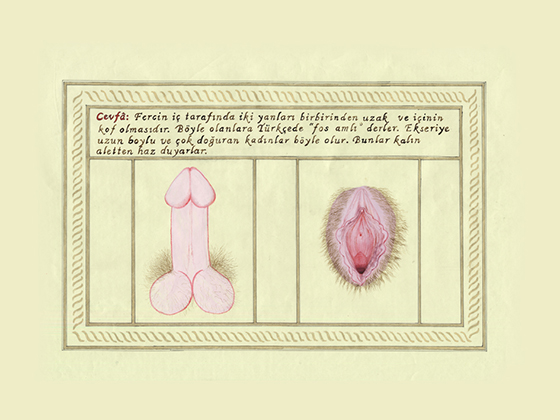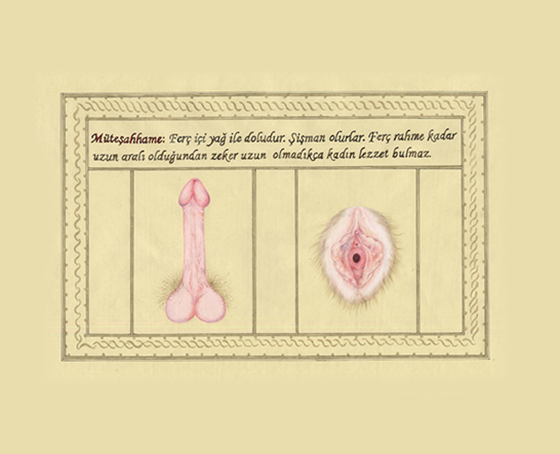Bahname (2007)
Painting series, 8 pages
I
nk, gold on special paper
The word “Bahname” is a noun comprising “bah,” the Arabic word for sexual desire, sexual potency, and lust; and “name,” the Farsi word for book or booklet.
These type of works, known under the general heading of “Bah-name” in Islamic medicine, parallel Western world’s similar works by Hippocrates in the fifth century BC or the first century doctor Galen of Bergama. They are not pornographic books by any means; had they been written today, they would be studied under andrology. These works explain subjects like aesthetics --especially in female beauty--, points to be considered while choosing partners, body cleanliness, cosmetics, deodorants, and conducts of sexual act according to the knowledge of the times.
Islamic medicine of the middle ages derives from and reevaluates the Greek and Roman medicinal knowledge accumulated through translated works. Written in Arabic from the ninth century onwards, the bahnames were later produced in Farsi. The first examples of these works were composed through the 15th century.(1)
The texts featured in the works of this exhibition are excerpts from the 17th century bahname of Tabib (Doctor) Mustafa Ebu’l Feyz, “Tuhvetü’l Müteehhilin.”
“Tuhvetü’l Müteehhilin’I,” which roughly means “The Natural Impulse in the Desire for Sexual Intercourse” in today’s language, has been translated into modern Turkish by Prof. İlter Uzel as “Evlilik Armağanı (Wedding Gift).”
…The Republic of Turkey was founded after renovating itself at the end of the Empire’s century of destruction. Meanwhile, the language of its multi-layered sexual culture was unfortunately abandoned. Islam had never banned love-making outside of the male hegemony; instead had encouraged this. However, the Islamic language for this topic was now being locked behind closed doors. It took a while for the educated women of the Republic’s second and third generations to be able to tell each other the discomfort they felt at seeing that word composed of “a” and “m”(2) on bathroom doors. We know that there are little girls with “kukus” or women with “vaginas” in this country; today we even have the opportunity to be international objects of erotica with “pussies;” we can even swear “amına koyim (f… yours)” but the part between our legs has been deemed nameless, abandoned, and left to feel guilty even to lead simple, comfortable girl talk…
…The first chapter of “Evlilik Armağanı (Wedding Gift)” explains the qualities of beautiful women. The second chapter classifies the female organ, or rather “ferç...”
…Ferç means “opening, cut” in Arabic. It is said that “if the mouth of the beloved is small, then her ferç is narrow; the redder her tongue, the drier her ferç shall be.” This is how the ferç has been classified and named by male doctors centuries ago.(3)
(1)Uzel, İlter, “Tuhfetü’l Müteehhilin Evlilik Armağanı, Tabib Mustafa
Ebu’l Feyz”, Kebikeç Yayınları pages. 3-6
(2)Artist’s note. Am (noun): Turkish slang for the female organ.
(3)Koç, Handan, “Bahname’den cinsel organımız için isimler sözlüğü”,
Pazartesi Dergisi, issue:109, file:2, Cinsellik, pages.97-98

Fehvâ (Concept): The ferç is too humid, and thus the inside wide and cold. These can not know the pleasures of cima, their lusts are not satisfied, and they have intercourse when the ferç is heated. Instead of thrusting the member inside back and forth, they enjoy rubbing crotches. Therefore, they tend not to like men, but prefer rubbing against their own kind.

Cevfâ (Hollow): The two sides of the ferç are far from each other, and the inside is hollow. These types are called “fos amlı (rotten/hollow pussy)” in Turkish. Especially tall women and those who have given too many births are of this type. These enjoy thick members

Ka’râ (Dip): This ferç is concave since the uterus is far, and the womb is long. This type of ferç needs a thick and hooded zeker4 for the sensitive zone to be reached.
4 Zeker: Slang for penis, member.

Lezika (Loose):
Though initially filled with fat, the ferç is emptied out after losing
weight, and is loose and saggy even though the two kıynaks1 are
stuck together. Unless the alet2 entering this kind of ferç is short and thick, the beloved
shall not enjoy cima2.
[i]
Kıynak:
the two cheeks of the buttocks. The word “kıynak” means halved walnut or the
knobby nails or “claws” of birds of prey. Figuratively it has been used
instead of “şak,” the two sides of the butt. In the bahname, the two soft
ends of the buttocks are referred to as “kıynak,” and the top area as “pöç.”
In this text the word has been used to define the two sides of the ferç.
2Alet: 1- Tool. 2- Slang
for penis, member.
3Cima:
human sexual intercourse. From the root “cem,” meaning being beside each
other, uniting, gathering.

Mütehannika (Firm): The kıynaks, the two sides of the outside of the ferç, are thick and dense, and the inside filled and firm. Such a beloved is named “Hıtayi.” 5 These enjoy cima with firm, thin and long members.
Hıtayi: Chinese, like Chinese. A member of the Turkish or Tartar tribes from Northern China.

Mütehhattime (Sufficient): The top and the bottom parts of the ferç are equal; the distance to the uterus is short, and the release rapid. These beloveds like to reach pleasure quickly with a medium sized member. If there is too much movement, because of its fragility her kutu5 is bruised, and the woman feels pain and distress.
5 Kutu: (Literally) Box.

Müteşahhame (Fat-filled): The Ferç (opening, cut, split) is filled with fat on the inside. These women tend to be fat. Since the ferç is far from the uterus, the woman tends not to reach pleasure unless the penis is long.

Şekrâ (Dry): The two sides of the ferç are lean and dry. These types enjoy thin and long members. When the member enters, it should especially move towards the lean areas, meaning it should churn these parts. Otherwise, the beloveds shall not reach pleasure.